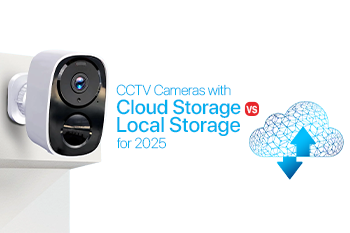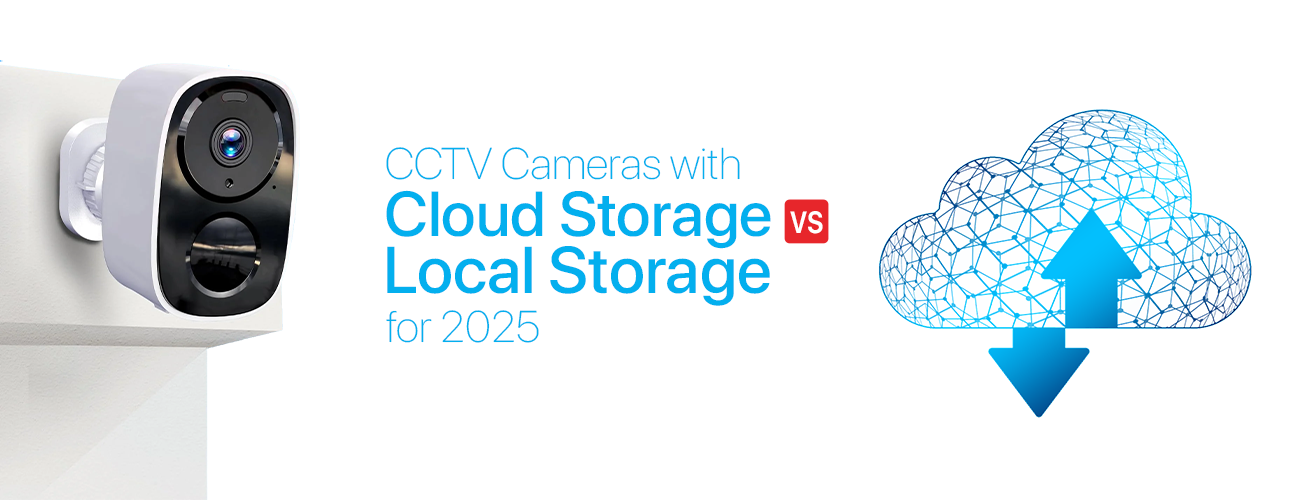CCTV Cameras with Cloud Storage vs Local Storage for 2025


The role of storage in video surveillance is critical, directly impacting the usability, accessibility, security, and preservation of CCTV footage. Though storage has remained an unsung hero, it plays a key role in retaining footage for an extended period of time, ensuring data security and redundancy as well as retrievability of the recorded footage, and determining the system performance.
Therefore, you should give utmost care to choose a storage type that meets your specific surveillance needs. When it comes to storage, there are three types of surveillance storage available in the market: cloud storage, local storage, and hybrid storage. Each of them has a specific set of pros and cons that you must know before making an ultimate decision.
In this write-up, we are discussing in depth each type of CCTV storage so that you can make a well-informed decision vis-à-vis which surveillance storage you should select.
Let’s get started!
Overview of CCTV Storage Options:
CCTV storage is of the three types:
-
Local Storage
-
Cloud Storage
-
Hybrid Storage
What is Local Storage?
Local storage is an on-site storage wherein data is stored locally on hard drives such as SSDs or HDDs, or they are stored on servers housed in dedicated data centers. These on-site storage devices are located within the user’s premises. Local CCVT allows storing footage directly onto devices that are connected to CCTV cameras.
On-premises storage has been the most trusted type of storage, from small-scale storage to large-scale city surveillance systems. Users trusted on-site storage for its cost-effectiveness and robust security features.
Users can choose various local storage options. Let’s discuss one by one.
-
SD Cards:
SD cards are the least costly local storage option that you can choose. They store data on a small chip that is housed inside a plastic casing. These cards are portable, allow uninterrupted recording even during network outages, and they also reduce network traffic.
The size of a typical SD card can range from 32GB to 512 GB. However, it should be noted that the resolution of the camera can influence the duration of storage. For instance, a full HD 2MP camera with H.265 compression can utilize 15GB a day. Obviously, for higher resolution like 4K, you need at least 256GB or 512GB SD cards to avoid frequent overwriting.
The downsides of SD cards are also there. First, they offer limited storage space; second, they can potentially fail or corrupt, causing permanent loss of data.
Important SD cards that you should look into are as follows:
-
Kingston High Endurance microSD
-
SanDisk High Endurance microSD
-
Samsung Pro Endurance
-
Hard Drive Storage:
Hard Disk Drives (HDDs) or Solid-State Drives (SSDs) can also be used for CCTV local storage for video surveillance. Hard Drives are more reliable than SD cards, and they offer more space as well. Hard Drives are either built within the CCTV camera or are made part of a Digital Video Recorder (DVR) or a Network Video Recorder (NVR).
SSD drives are often preferred to HDDs because they offer faster speed, better durability, silent operations, enhanced power efficiency, less boost time, less than 0.1 ms data access time, minimum heat generation, longer lifespan, and more.
However, the flip side of hard drives is also there. Installation of hard drives requires specialized expertise and accessories. They are also prone to damage and data loss.
Top Surveillance Hard Disk Drive (HDD) for CCTV Storage:
-
WD Purple
-
WD Purple Pro
-
Toshiba S300
Top Surveillance Solid State Drives or SSDs for CCTV Footage:
-
Samsung Portable SSD T7 Touch
-
Crucial MX500 (SATA SSD)
-
Western Digital Blue SN570 (NVMe SSD)
-
Network Attached Storage or NAS:
Finally, Network Attached Storage or NAS is an external storage device that is used for storing CCTV footage. They allow users access to recorded footage from multiple devices and at multiple locations. NAS can be configured, minimizing the threats of data losses; furthermore, they also come with advanced data redundancy capabilities, making them suitable for a scalable and enterprise-grade surveillance infrastructure.
Top NAS Solutions for Video Surveillance:
-
UGREEN NASync DXP2800
-
QNAP TS-983XU-RP
-
Asustor AS5402T
-
TerraMaster F4-424 Pro
-
TS-983XU-RP
-
TVS-672N
Now, we have discussed in depth the basics of local storage. Here are some pros and cons of on-premise CCTV storage.
-
Pros of Local CCTV Storage:
Here are some pros of on-premise surveillance storage that you need to know.
-
Privacy & Control:
Privacy is one of the biggest advantages of having local storage. Unlike cloud storage, which is subject to the stringent surveillance of government agencies and prone to the risk of cyber threats, local storage is perfectly safe. All footage remains within the cameras or your premises, and you have complete control over it, including managing, securing, and accessing data as you see fit.
-
No Subscription Fee:
On-premise storage infrastructure is a one-time investment. You need to purchase all necessary hardware, including cameras, SSDs, HDDs, or NAS for once, and after that, you don’t need to pay a subscription fee to access them as with case cloud storage. You can save a lot of money in the long run.
-
Reliable Security:
Security is another major pro of on-site storage infrastructure. Since data is stored locally and not transmitted through a network to remote cloud storage, the level of security against cyber criminals is higher. Furthermore, you can also add customized security protections, including firewalls and encryption, as per your particular needs.
-
Internet-independent Storage:
Cloud storage requires a robust and high-bandwidth network connection, making it unsuitable for areas where the network is unreliable. Local storage does not require any network connection, making it suitable for large firms and corporations that demand 24/7 surveillance without any downtime for whatever reason.
-
Cons of On-Premise/On-site Storage Solution:
Local CCTV storage also suffers from some drawbacks. Here are some of them:
-
Physical Vulnerability:
This is one of the biggest shortcomings of on-site storage as they are vulnerable to theft, hardware failure, or disasters or accidents such as fire or floods. These vulnerabilities can cause permanent damage to data, and it can prove quite devastating for you both in terms of reputation damage and legal liabilities.
-
Limited Space:
Limited space is another major problem. Most on-site storage solution comes with limited storage, forcing users to overwrite older footage again and again to create space for new footage. This is a headache, making maintenance a demanding and labor-intensive job.
-
Limited Accessibility:
Since data is stored physically on local disks or NAS devices, therefore, on-premise storage does not support remote accessibility. This is a major concern for users who need to monitor their premises 24/7 from everywhere, or when law enforcement agencies need to access footage.
-
Higher Maintenance Cost:
The hardware infrastructure of local storage needs frequent repairs, maintenance, and upgrades to match the evolving cyber threat spectrum and security needs. This proves quite costly for small and medium enterprises and homeowners.
Local storage is now done. We now move to another section that is related to Cloud Storage. Let’s get the ball rolling!
What is Cloud Storage?
Cloud storage is, unlike local storage, used to store CCTV footage on remote servers, which are accessed through the internet. The remote storage of footage on third-party cloud infrastructure allows users to access it from anywhere and at any time, provided that they have a stable internet connection.
The working of cloud-based storage is simple, involving cameras that stream their videos to remote servers. Only authorized users can access footage through a web interface or mobile app.
Top Cloud Storage Cameras in the USA
-
SimpliSafe - Best Cloud Plan with Monitoring
-
ADT - Best Cloud Cameras with Video Verification
-
Google Nest - Best Cloud Cameras with Facial Recognition
-
Ring - Best Affordable Cloud Security Camera
-
Arlo - Best DIY Cloud Security Camera
-
Wyze - Most Affordable Cloud Camera System
Similar to local storage, cloud-based storage also features both advantages and disadvantages. Let’s discuss them one by one.
Pros of Subscribing to Cloud Storage for CCTV Surveillance:
Here are some pros that one should know.
-
Scalability:
One of the biggest advantages of cloud storage is easy scalability. You can grow the capacity of storage as your business grows quite easily, and without purchasing any additional hardware. Therefore, cloud-based storage is suitable for both SMEs and large-scale organizations.
-
24/7 Remote Accessibility:
Cloud CCTV storage allows authorized users to access their data from anywhere and at any time, either through a mobile app or a web-based interface.
For instance, Arlo Secure allows you to access your CCTV footage by just logging in to your account on smartphones.
Cons of Cloud-based Storage:
Similar to anything in the world, there are disadvantages to cloud storage as well. For instance:
Security Risks:
Even though cloud storage service providers implement robust security measures, the data is still transmitted through the network, making it vulnerable to cyberattacks. Hackers can try to exploit this vulnerability to implement their nefarious designs.
Recurring Expenditure:
You need to pay a monthly or annual subscription fee for access to cloud storage. This fee adds up over time and can consume a significant portion of your income, particularly for those large organizations that need significant storage capacity with advanced features.
Cloud Storage vs Local Storage: Which One Best Serves Your Needs in the USA?
Here is a table highlighting the major differences between these two storage solutions.
|
Features |
Local Storage |
Cloud Storage |
|
Accessibility |
Local network or on-site physical |
Anywhere at any time through a network connection |
|
Security |
Robust, though vulnerable against physical threats |
Vulnerable to cyber threats |
|
Storage Capacity |
Limited by local storage hardware |
Unlimited storage |
|
Cost |
Higher initial cost, but no recurring cost |
Lower upfront cost, but recurring cost as a result of the subscription |
|
Data redundancy |
Limited |
High, automatically maintained |
|
Installation |
Complex, specialized skills are required |
Simple, |
|
Maintenance |
User-managed, regular updates required |
Minimal user involvement, done by the service provider |
What is Hybrid Storage and What Benefits Does It Offer?
Hybrid storage for CCTV, as the name indicates, is a combination of local storage and cloud storage, offering security managers a reliable and flexible storage solution for their video surveillance systems. You can thus enjoy the best of both worlds: scalability to expand the CCTV network of cloud storage and secure and fast access to a local storage setup. More importantly, you can store sensitive data on local storage and keep it as a backup on a hybrid, enjoying data redundancy as well.
It offers multiple advantages. For instance:
Flexibility and Scalability:
Hybrid storage allows easy adding of more cameras and other components of video surveillance systems without any need to overhaul the existing infrastructure. You can thus grow your security system in line with the growing and expanding needs of your business.
Security:
Since data can be stored on local servers and its backup can be maintained on remote cloud servers, you can provide robust and reliable data security for your organization. This redundancy leads to minimized risks of data loss, either due to cyberattacks or other physical threats such as theft or accidents etc.
Remote Access & Management:
Since it features cloud access, hybrid storage allows remote access, making it suitable for those organizations and homeowners who want to access live-feed or recorded footage from everywhere and at any time.
Here are our final recommendations:
Use-Cases Where Local Storage is Required:
First, Local CCTV storage is recommended for sensitive and high-security infrastructure where data privacy and integrity are of top priority for users.
Second, for those startups, SMEs, and homeowners that are budget-constrained and neither want nor can afford to pay a monthly or annual recurring subscription fee.
Third, for those organizations and individuals who know how to install, manage, and maintain local storage, this option should be explored seriously.
Use-Cases Where Cloud Storage is Recommended:
First, for those users who want remote monitoring and surveillance all the time, they must go for cloud-based storage solutions.
Second, for startups, SMEs, and businesses undergoing expansion, who consequently need scalable, cloud solutions, should adopt them without hesitation.
Third, for individuals and organizations that lack specialized knowledge and want to implement a hands-off approach to enjoy maintenance-free surveillance systems, should go for cloud storage.





